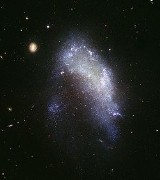
Irregular galaxy
Overview
Galaxy
A galaxy is a massive, gravitationally bound system that consists of stars and stellar remnants, an interstellar medium of gas and dust, and an important but poorly understood component tentatively dubbed dark matter. The word galaxy is derived from the Greek galaxias , literally "milky", a...
that does not have a distinct regular shape, like a spiral
Spiral galaxy
A spiral galaxy is a certain kind of galaxy originally described by Edwin Hubble in his 1936 work The Realm of the Nebulae and, as such, forms part of the Hubble sequence. Spiral galaxies consist of a flat, rotating disk containing stars, gas and dust, and a central concentration of stars known as...
or an elliptical galaxy
Elliptical galaxy
An elliptical galaxy is a galaxy having an approximately ellipsoidal shape and a smooth, nearly featureless brightness profile. They range in shape from nearly spherical to highly flat and in size from hundreds of millions to over one trillion stars...
. The shape of an irregular galaxy is uncommon – they do not fall into any of the regular classes of the Hubble sequence
Hubble sequence
The Hubble sequence is a morphological classification scheme for galaxies invented by Edwin Hubble in 1926. It is often known colloquially as the Hubble tuning-fork diagram because of the shape in which it is traditionally represented....
, and they are often chaotic in appearance, with neither a nuclear bulge
Bulge (astronomy)
In astronomy, a bulge is a tightly packed group of stars within a larger formation. The term almost exclusively refers to the central group of stars found in most spiral galaxies...
nor any trace of spiral arm structure. Collectively they are thought to make up about a quarter of all galaxies. Most irregular galaxies were once spiral or elliptical galaxies but were deformed by disorders in gravitational pull.
Unanswered Questions

